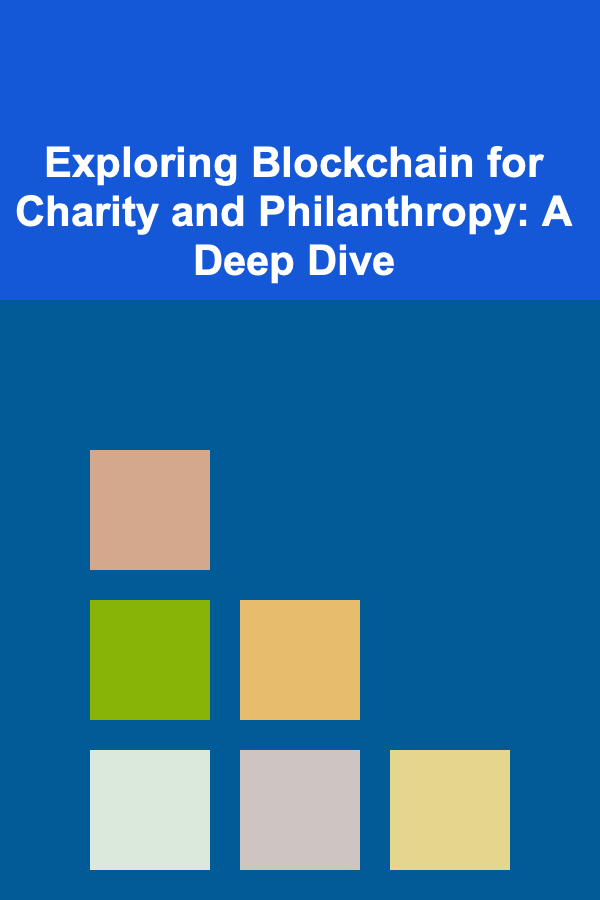
Exploring Blockchain for Charity and Philanthropy: A Deep Dive
ebook include PDF & Audio bundle (Micro Guide)
$12.99$5.99
Limited Time Offer! Order within the next:

The world of charity and philanthropy is constantly evolving, seeking new and innovative ways to maximize impact and ensure transparency. Blockchain technology, with its inherent characteristics of immutability, transparency, and security, presents a compelling opportunity to revolutionize how charitable organizations operate, raise funds, and deliver aid. However, navigating the complexities of blockchain and its potential applications within the philanthropic sector requires careful consideration and a deep understanding of its capabilities and limitations.
The Promise of Blockchain in Charity and Philanthropy
Blockchain, at its core, is a distributed, decentralized, and tamper-proof ledger. This fundamental structure provides several key advantages for charitable organizations:
- Enhanced Transparency: Every transaction recorded on a blockchain is publicly visible and auditable. This level of transparency can significantly improve donor trust, as donors can track their contributions from donation to impact.
- Reduced Administrative Costs: By automating processes and eliminating intermediaries, blockchain can streamline operations and reduce administrative overhead, allowing more funds to reach the intended beneficiaries.
- Improved Traceability: Blockchain enables the tracking of goods and resources along the supply chain, ensuring that aid reaches the correct recipients and minimizing the risk of diversion or fraud.
- Increased Security: The cryptographic security of blockchain makes it difficult to tamper with data, protecting against fraud and corruption.
- Direct Giving and Micropayments: Blockchain facilitates direct giving and micropayments, allowing donors to contribute smaller amounts directly to beneficiaries, bypassing traditional fundraising channels.
- Automated Compliance and Reporting: Smart contracts can automate compliance processes and generate transparent reports, reducing the burden of regulatory requirements.
Key Areas for Blockchain Application in Philanthropy
The potential applications of blockchain in charity and philanthropy are vast and span various areas of operation:
1. Transparent Donation Tracking and Management
Traditional charity models often struggle with demonstrating the effective use of donations. Blockchain provides a solution by offering a transparent and auditable record of all transactions. Each donation can be tagged with metadata, allowing donors to track its journey from the initial contribution to its final destination, such as funding a specific project or providing resources to a beneficiary.
Example: Imagine a charity focused on providing clean water in developing countries. Using a blockchain-based system, donors can contribute directly to a specific water well project. The blockchain records the donation, tracks the purchase of materials, the labor costs, and the final completion of the well. Donors can then view the progress and see the impact of their contribution directly on the blockchain ledger.
2. Streamlining Aid Distribution and Supply Chains
In disaster relief and humanitarian aid, efficient and transparent supply chains are crucial. Blockchain can be used to track the movement of goods and resources from the point of origin to the beneficiaries, ensuring that aid reaches those who need it most. This is particularly useful in complex environments with multiple stakeholders and potential for corruption.
Example: Following a natural disaster, a relief organization can use blockchain to track the distribution of food, medicine, and shelter. Each item can be tagged with a unique identifier and its movement recorded on the blockchain. This provides a clear audit trail, preventing theft, diversion, and ensuring that aid is delivered to the intended recipients.
3. Empowering Beneficiaries Through Direct Payments
Blockchain can enable direct payments to beneficiaries, cutting out intermediaries and reducing administrative costs. This is particularly beneficial for programs that provide financial assistance or direct aid to individuals or families.
Example: A charity providing educational scholarships can use blockchain to disburse funds directly to students' digital wallets. The students can then use these funds for tuition, books, and other educational expenses. The blockchain records the transactions, providing transparency and accountability for both the charity and the recipients.
4. Building Trust and Accountability with Smart Contracts
Smart contracts are self-executing contracts written in code and stored on the blockchain. They can automate processes, enforce agreements, and ensure that funds are used according to the terms of the contract. This is particularly useful for projects with specific goals and timelines.
Example: A charity raising funds for a specific research project can use a smart contract to ensure that the funds are only released to the researchers upon achieving pre-defined milestones. The smart contract can automatically verify the milestones and release the funds accordingly, ensuring transparency and accountability.
5. Fostering Community Engagement and Governance
Blockchain can be used to create decentralized autonomous organizations (DAOs) that empower community members to participate in decision-making and governance. This can lead to more inclusive and transparent charitable organizations.
Example: A community-based charity can use a DAO to allow community members to vote on how funds are allocated and which projects are prioritized. The voting process is transparent and auditable on the blockchain, ensuring that the community's voice is heard.
6. Creating Secure and Transparent Digital Identities
For vulnerable populations, establishing a secure and verifiable digital identity is crucial for accessing services and receiving aid. Blockchain can be used to create self-sovereign identities that individuals control, empowering them to manage their own data and access essential services.
Example: Refugees often lack official documentation, making it difficult to access aid and services. A blockchain-based digital identity system can provide refugees with a secure and verifiable identity, allowing them to access healthcare, education, and other essential services.
Challenges and Considerations
While blockchain offers significant potential for charity and philanthropy, it is important to acknowledge the challenges and considerations associated with its implementation:
- Scalability: Some blockchain networks have limited transaction processing capacity, which can be a bottleneck for large-scale deployments.
- Cost: Implementing and maintaining blockchain solutions can be expensive, requiring specialized expertise and infrastructure.
- Complexity: Blockchain technology can be complex and difficult for non-technical users to understand.
- Regulatory Uncertainty: The regulatory landscape for blockchain is still evolving, and there is uncertainty about how it will be treated in different jurisdictions.
- Data Privacy: While blockchain offers transparency, it is important to protect the privacy of sensitive data. Careful consideration must be given to data anonymization and encryption techniques.
- Security Risks: Despite its inherent security, blockchain systems are still vulnerable to attacks, such as phishing and social engineering.
- Lack of Interoperability: Different blockchain networks may not be interoperable, making it difficult to transfer data and assets between them.
- Energy Consumption: Some blockchain networks, particularly those using proof-of-work consensus mechanisms, consume significant amounts of energy.
- Skills Gap: There is a shortage of skilled blockchain developers and experts, which can make it difficult to find qualified personnel to implement and maintain blockchain solutions.
Overcoming the Challenges
Despite these challenges, there are strategies that can be used to overcome them and maximize the potential of blockchain for charity and philanthropy:
- Choosing the Right Blockchain: Selecting the appropriate blockchain network for a specific use case is crucial. Consider factors such as scalability, cost, security, and regulatory compliance. Private or permissioned blockchains may be more suitable for some applications.
- Focusing on User Experience: Designing user-friendly interfaces and applications is essential to ensure that blockchain solutions are accessible to non-technical users.
- Investing in Education and Training: Providing education and training to staff and volunteers is crucial to building the necessary skills and knowledge to implement and maintain blockchain solutions.
- Collaborating with Experts: Partnering with blockchain experts and technology providers can help organizations navigate the complexities of the technology and develop effective solutions.
- Adopting a Phased Approach: Implementing blockchain solutions in a phased approach, starting with small pilot projects, can help organizations learn and adapt as they go.
- Addressing Regulatory Concerns: Staying informed about the evolving regulatory landscape and working with legal experts can help organizations ensure compliance.
- Prioritizing Data Privacy: Implementing appropriate data anonymization and encryption techniques is crucial to protect the privacy of sensitive data.
- Utilizing Second-Layer Solutions: Exploring second-layer solutions, such as payment channels and sidechains, can help improve scalability and reduce transaction costs.
- Promoting Interoperability: Supporting initiatives that promote interoperability between different blockchain networks can help facilitate the transfer of data and assets.
- Exploring Energy-Efficient Alternatives: Consider using blockchain networks that utilize more energy-efficient consensus mechanisms, such as proof-of-stake.
Examples of Blockchain in Action for Social Good
Several organizations are already exploring and implementing blockchain solutions for various charitable and philanthropic purposes:
- World Food Programme (WFP): The WFP has used blockchain to distribute cash assistance to Syrian refugees in Jordan, enabling them to purchase food and other essential items directly from local retailers. The system, called Building Blocks, reduces fraud and transaction costs, while empowering refugees to manage their own resources.
- UNICEF: UNICEF CryptoFund invests in and supports early-stage, open-source blockchain solutions that have the potential to benefit children around the world.
- BitGive Foundation: BitGive is a nonprofit organization that uses Bitcoin and blockchain technology to support global philanthropic projects. They provide a transparent and accountable platform for donors to track their contributions and see the impact of their giving.
- Alice.si: Alice.si is a platform that uses blockchain to track the impact of social projects. Donors can track their contributions in real-time and see how their money is being used to achieve specific goals.
- Plastic Bank: Plastic Bank is a social enterprise that collects ocean-bound plastic and exchanges it for money, items, or blockchain-secured digital tokens. This provides a sustainable income source for vulnerable communities while addressing the problem of plastic pollution.
The Future of Blockchain in Philanthropy
As blockchain technology continues to mature and become more accessible, its potential to transform charity and philanthropy will only grow. In the future, we can expect to see:
- More Widespread Adoption: As awareness of the benefits of blockchain increases, more charitable organizations will adopt the technology to improve their operations and impact.
- Integration with Existing Systems: Blockchain solutions will be integrated with existing charitable systems and platforms, making it easier for organizations to adopt the technology.
- Greater Focus on Impact Measurement: Blockchain will be used to track and measure the impact of charitable programs more effectively, allowing organizations to demonstrate their value and attract more funding.
- Development of New Funding Models: Blockchain will enable new funding models, such as impact investing and social impact bonds, that align financial returns with social outcomes.
- Empowerment of Beneficiaries: Blockchain will empower beneficiaries by giving them more control over their data and resources, and by enabling them to participate in decision-making processes.
- Increased Collaboration: Charitable organizations will collaborate more closely with each other and with technology providers to develop and deploy blockchain solutions.
Conclusion
Blockchain technology holds immense promise for revolutionizing the charity and philanthropy sector. By enhancing transparency, reducing costs, improving traceability, and empowering beneficiaries, blockchain can help charitable organizations achieve their missions more effectively. While challenges remain, the potential benefits of blockchain are too significant to ignore. By embracing this technology and addressing the associated challenges, the philanthropic sector can unlock new opportunities to create a more equitable and sustainable world.
It is crucial for charitable organizations to approach blockchain with a strategic mindset, carefully considering their specific needs and goals. A thorough understanding of the technology, its potential applications, and its limitations is essential for successful implementation. By embracing innovation and collaboration, the philanthropic sector can harness the power of blockchain to make a lasting difference in the lives of those in need.

How to Incorporate Multi-Functional Furniture into Your Hobby Room
Read More
How to Use Baskets and Bins for Tidy Storage
Read More
Mastering Finance Leadership: A Comprehensive Guide for Chief Financial Officers
Read More
Friendship First: The Foundation of Lasting Love
Read More
10 Tips for Improving 3D Printing Accuracy for Engineers
Read More
10 Tips for Creating a Study Schedule Planner for Homeschooling High School
Read MoreOther Products

How to Incorporate Multi-Functional Furniture into Your Hobby Room
Read More
How to Use Baskets and Bins for Tidy Storage
Read More
Mastering Finance Leadership: A Comprehensive Guide for Chief Financial Officers
Read More
Friendship First: The Foundation of Lasting Love
Read More
10 Tips for Improving 3D Printing Accuracy for Engineers
Read More